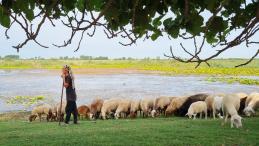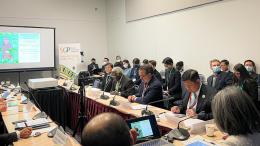On 29 January 2024, UNU-IAS co-hosted a session of the 15th International Forum for Sustainable Asia and the Pacific (ISAP 2023). The session focused on the Satoyama Development Mechanism (SDM) — a seed funding programme that supports projects to promote, conserve or restore socio-ecological landscapes and seascapes (SEPLS). The event was organized in partnership with the Institute for Global Environmental Strategies (IGES).
Opening the session, Kazuhiko Takeuchi (President, IGES; Visiting Professor, UNU-IAS) highlighted the urgency of addressing multiple environmental challenges through transformative change. He underscored the potential of the SEPLS approach to drive integrated, inclusive and localized actions for a nature-positive society.
Koji Miwa (Policy Researcher, Biodiversity and Forest, IGES) introduced SDM as a collaborative activity of the International Partnership for the Satoyama Initiative (IPSI), which has funded 64 projects in over 20 countries.
Recipients of SDM grants in 2022 showcased their projects and outcomes. Discussing biodiversity loss in the Sundarbans mangrove forest in Bangladesh, Bayezid Khan (Researcher, Unnayan Onneshan) explained how a project had facilitated community-based mangrove restoration, integrated farming, and innovative agriculture through consultations and workshops. Malin Jönsson (Director, Fundacion Semillas de Vida, A.C.) detailed efforts to conserve maize biodiversity and the local food supply in Mexico. The project ensured access to locally produced seeds and published a manual to disseminate traditional knowledge of seed conservation.
The Tse-Xin Organic Agriculture Foundation (TOAF) explained how traditional farming knowledge maintained and enhanced biodiversity in Taiwan, China. Alice JJ Hsu (Project Coordinator, TOAF) highlighted community seed banks and learning farms for elders to pass on traditional agricultural practices to younger generations, in addition to planting native plants to decrease the use of herbicides and weeding.
Dese Yadeta Edesa (Researcher, Ethiopian Biodiversity Institute) outlined a project on area-based conservation and restoration to protect the endangered Yeheb plant in Ethiopia, which provides food and medicine to local communities. An area of 504 hectares was brought under ecological restoration through its designation as an other effective area-based conservation measure (OECM). A nursery was established with over 170,000 Yeheb seedlings, supporting more than 8,000 families to retain a valuable resource for their livelihoods and well-being.
A panel discussion highlighted the holistic and inclusive nature of the SEPLS approach to agriculture. It addressed the exclusion of indigenous people and local communities (IPLCs) in planning and decision-making procedures, production activities, and the well-being of nature and communities through a sustainability lens.
In closing remarks, Wataru Suzuki (Director, Biodiversity Strategy Office, MOEJ) pointed out that while SDM was a small-scale funding mechanism, it had successfully filled gaps, providing valuable experiences and lessons learned from community engagement. He reiterated that such on-the-ground activities significantly contributed to the conservation and sustainable use of biodiversity.


